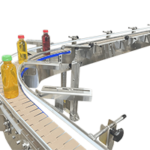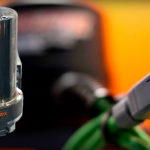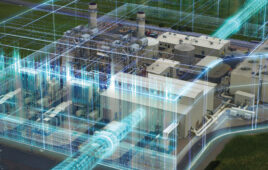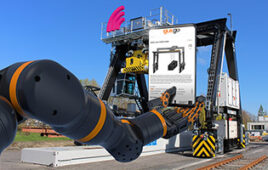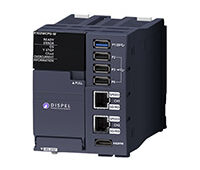Digital transformation (DX) initiatives continue to make headlines. The buzzword is synonymous with improving automation, safety, and efficiency in the manufacturing industry. More facilities than ever are integrating Industry 4.0 technologies such as sensors, IoT, and robots, into their operations to enhance modernization efforts, increase efficiency, and reduce downtime. Here, wireless charging of equipment found in DX facilities such as autonomous mobile robots (AMRs) provides distinct advantages.
By Brian Cook • Senior product manager | Conductix-Wampfler
Less than half of all manufacturing executives have leveraged DX data insights to enact modernization strategies. So while DX adoption in automation is making progress, there’s still plenty of room for growth. The first step in many operations? Facility managers must identify operational gaps to make the most of these technologies — including infrastructures to charge wireless and mobile systems such as AMRs.
Charging and data-connection strategies continue to be afterthoughts for facilities, but there’s a lot of untapped potential in harnessing the technologies. Wireless equipment designed to transfer data and power enhances automation, mobilization, and interconnectivity across facilities and warehouses.
Here are five things to know about how wireless connectivity can improve productivity and set a business up for future success.

Wireless chargers can support DX and other modernization efforts to help businesses operate at full capacity with a given infrastructure. As engineers consider implementing DX technologies into current operations, use of wireless charging and communication should be a top priority.
1. Wireless connections allow seamless integration.
When first considering wireless charging implementation, a few questions commonly arise: How will this integrate into the current infrastructure? Will the implementation cause unnecessary downtime for the facility? Will operations need to purchase new equipment? Designed to be compatible with automated systems, wireless charging often integrates quite seamlessly into set manufacturing and industrial processes sans the need for new equipment or significant downtime. Because wireless connections are don’t require the manual connection of power supplies, they best support autonomous operations aimed at trimming operations costs.
2. Wireless connections impart enhanced flexibility and mobility.
Once implemented, wireless chargers continue to enhance productivity by promoting flexibility and mobility in manufacturing environments — two Industry 4.0 priorities. Industry processes constantly shift and evolve, so it is important to arm facilities with a flexible charging strategies that can adapt and meet production demands. Wireless charging systems can be stationed in multiple locations within a warehouse or facility, providing greater flexibility for facility workers and operators.
AMRs especially can take advantage of the enhanced mobility and charging locations with so-called opportunity charging. More specifically, the robots can navigate to any of the charging stations and connect without the need for hardwired power. The result is less downtime, more productivity, and increased throughput.
3. Wireless connections improve data capture.
The core of Industry 4.0 and DX operations is the use of data. Equipment-specific data can help identify bottlenecks and create better manufacturing processes. Engineers might not traditionally think of charging infrastructures as a data source, but they can be. Some wireless chargers for AMRs are designed with data-transfer capabilities to let robots parked for charging simultaneously up and download software updates, assignments, and metrics to the central control system. This improves communication and visibility across a facility by allowing the collection and use of information to optimize operations, eliminate downtime, and enhance safety protocols.

Deploying a wireless charging strategy can help address operational inefficiencies by reducing downtime, enhancing flexibility and safety, and informing business decisions with data-based insights.
4. Wireless connections boost safety and reliability.
Wireless charging systems can improve the safety of warehouses and manufacturing facilities. Traditional contact charging solutions are outfitted with long wires, posing potential electrical and tripping hazards for employees and robotics. Such chargers often require a careful and accurate connection or else sustain wear and tear — necessitating requiring regular inspections that waste maintenance personnel time.
In contrast, wireless chargers reduce the risk of electrical wire hazards by eschewing any mechanical wear of connections. That in turn protects staff and prevents equipment damage. What’s more, wireless chargers maintain higher data security than corded charging by enabling secure communication lines between charger and device. AMR vehicles especially require a high-speed connection for data transfer. Wireless chargers use inductive communication systems that ensure the correct operators receive and transmit data.
5. Wireless connections help futureproof operations.
As the need for automated manufacturing processes and practices continues to grow, relying on scalable technologies can enhance DX operations. Wireless charging systems are extremely scalable — allowing expansion to support larger mobile robotics fleets as new AMRs are added. Some solutions feature widely compatible connected communications and adaptability to upgrades.
Conductix-Wampfler | conductix.us

Brian Cook is a senior product manager at Conductix-Wampfler. With deep expertise spanning EV fleet management and charging infrastructure, Brian partners with engineers to bring new products to market faster. Prior to his role at Conductix, he served as Automation Project manager at Teledyne CETAC Technologies.
You may also like:
Filed Under: DIGITAL TRANSFORMATION (DX), Wireless devices, Robotics • robotic grippers • end effectors

